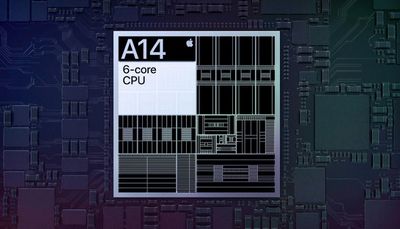Apple Executives Discuss the New A14 Chip and Apple's Approach to Chip Design
Between last month's introduction of the iPad Air with Apple's new A14 chip and tomorrow's expected unveiling of the iPhone 12 said to feature the same chip, Apple executives have been making the rounds talking up the technology behind the A14 and the company's overall chip strategy.

In a new interview with Engadget, Apple's vice president of platform architecture Tim Millet and senior director of Mac and iPad product marketing Tom Boger walked through how Apple has leveraged its ability to customize its own chips to focus on both energy efficiency and performance. Those competing priorities gain some new headroom with the A14 thanks to its transition to a smaller 5nm manufacturing process that packs more transistors into the same chip area and allows them to run at lower power.
The 5nm manufacturing process also allows Apple to devote more of the A14's capabilities to features beyond the traditional CPU and GPU functions, with the Neural Engine in the A14 doubling to 16 cores and capable of performing 11 trillion operations per second, nearly double that of the Neural Engine in the A13.
“We saw the opportunity to do things that would have been impossible to do with a conventional CPU instruction set,” Millet said. “You could in theory do many of the things the Neural Engine does on a GPU, but you can't do it inside of a tight, thermally constrained enclosure.”
On a broader level, Millet and Boger discussed how Apple's chip architecture team thinks about Apple's entire product portfolio, envisioning how its chips can be used not just in a single product but in multiple products over time.
When people at Apple start working on a chipset, they're not solely focused on building one for a single product; they take into account the company's entire lineup. “We spend a lot of time working with the product teams and software teams, and the architecture group really does sit in the center of that,” said Millet. [...]
“Ultimately, we want to make sure that when we build a CPU for one generation, we’re not building it necessarily only for one,” he said. While that doesn’t mean you’ll see the A14’s six-core CPU in something like an Apple Watch, the architecture developed for the company’s flagship phone chipset may well be adapted and reused elsewhere.
With the upcoming launch of Mac products based on Apple Silicon, we'll be seeing even more fruits of the chip team's labor, although Millet and Boger were unsurprisingly not ready to delve into discussions on that topic just yet.
For more on the A14 and Apple's in-house chip work, check out the full piece over at Engadget.
Popular Stories
Despite being more than two years old, Apple's AirPods Pro 2 still dominate the premium wireless‑earbud space, thanks to a potent mix of top‑tier audio, class‑leading noise cancellation, and Apple's habit of delivering major new features through software updates. With AirPods Pro 3 widely expected to arrive in 2025, prospective buyers now face a familiar dilemma: snap up the proven...
Apple plans to release an all-new super thin iPhone this year, debuting it alongside the iPhone 17, iPhone 17 Pro, and iPhone 17 Pro Max. We've seen pictures of dummy models, cases, and renders with the design, but Lewis Hilsenteger of Unbox Therapy today showed off newer dummy models that give us a better idea of just how thin the "iPhone 17 Air" will be.
The iPhone 17 Air is expected to be ...
If you missed the video showing dummy models of Apple's all-new super thin iPhone 17 Air that's expected later this year, Sonny Dickson this morning shared some further images of the device in close alignment with the other dummy models in the iPhone 17 lineup, indicating just how thin it is likely to be in comparison.
The iPhone 17 Air is expected to be around 5.5mm thick – with a thicker ...
A developer has demonstrated Windows 11 ARM running on an M2 iPad Air using emulation, which has become much easier since the EU's Digital Markets Act (DMA) regulations came into effect.
As spotted by Windows Latest, NTDev shared an instance of the emulation on social media and posted a video on YouTube (embedded below) demonstrating it in action. The achievement relies on new EU regulatory...
Apple's iPhone development roadmap runs several years into the future and the company is continually working with suppliers on several successive iPhone models simultaneously, which is why we often get rumored features months ahead of launch. The iPhone 17 series is no different, and we already have a good idea of what to expect from Apple's 2025 smartphone lineup.
If you skipped the iPhone...
Apple seeded the third beta of iOS 18.5 to developers today, and so far the software update includes only a few minor changes.
The changes are in the Mail and Settings apps.
In the Mail app, you can now easily turn off contact photos directly within the app, by tapping on the circle with three dots in the top-right corner.
In the Settings app, AppleCare+ coverage information is more...
While the iPhone 17 Pro and iPhone 17 Pro Max are not expected to launch until September, there are already plenty of rumors about the devices.
Below, we recap key changes rumored for the iPhone 17 Pro models as of April 2025:
Aluminum frame: iPhone 17 Pro models are rumored to have an aluminum frame, whereas the iPhone 15 Pro and iPhone 16 Pro models have a titanium frame, and the iPhone ...






















